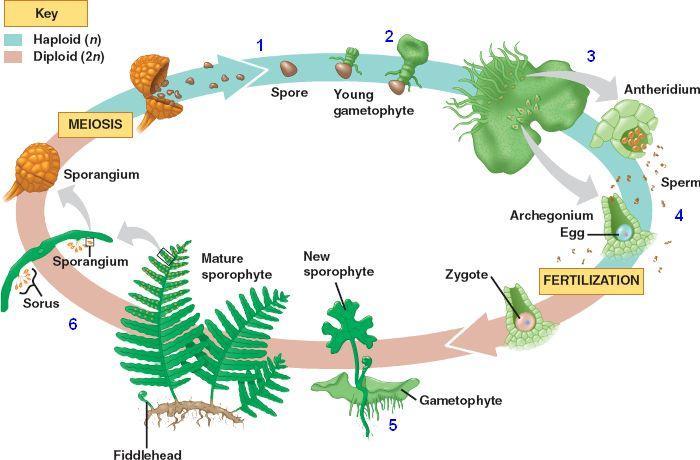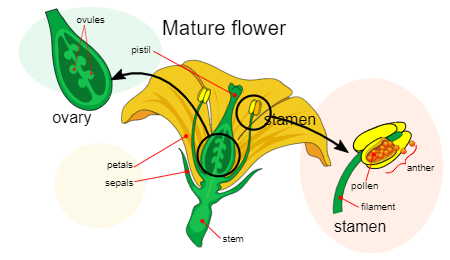Kingdom Plantae: Evolution and Life Cycles
1/44
Earn XP
Description and Tags
Slideshow Notes
Name | Mastery | Learn | Test | Matching | Spaced |
|---|
No study sessions yet.
45 Terms
Kingdom Plantae:
Eukaryotic
Multicellular
Autotrophic
What are the closest relatives to Plants?
Plants closest relatives are green algae (protists)
Charophytes
Charophytes are a group of green algae whose ancestral lineage gave rise to land plants in what resulted in a profoundly transformative event in the natural history of the planet
Evidence proving:
Plants closest relatives are green algae (protists)
Modern day charophytes and plants had a common ancestor
DNA (in chloroplasts and nucleus) is similar
Same structure for making cell wall, cellulose wall
Similar enzymes
Flagellated sperm is similar (in plants that produce flagellated sperm)- Think C Ferns
How did we go from alga to plant?
Algae are aquatic
Some may have lived on pond fringes
Ponds were ephemeral
Algae that had adaptations to this survived, reproduced, increased in numbers…
Plants vs Multicellular Algae
Plant Adaptations to Land
First land plants arose around 475 mya
Roots
Stem
Vascular Tissue (Xylem and Phloem) Cuticle
Stomata
Wind/Animal dispersed seeds/spores
Embryophytes
Alternation of Generations
predominant type of life cycle in plants and algae.
Consists of a multicellular haploid sexual phase, the gametophyte, which has a single set of chromosomes alternating with a multicellular diploid asexual phase, the sporophyte which has two sets of chromosomes.
Sporophytes produce spores via meiosis
Gametophytes produce gametes via mitosis
Fertilization can occur between two haploid gametes originating from different organisms of the same species or from the same organism.
Way in which all land plants and most algae undergo sexual reproduction.

gametophyte
“the haploid, multicellular, sexual reproductive stage in plants and algae that develops from spores and that gives rise to the male and female gametes which unite during fertilization to form the zygote”
sporophyte
“the diploid, multicellular, asexual reproductive stage in plants and algae that develops from the zygote and that produces spores”
gametophytes
“the haploid, multicellular, sexual reproductive stage in plants and algae that develops from spores and that gives rise to the male and female gametes which unite during fertilization to form the zygote”
Plants are all called _____ophytes
Plants are all called embryophytes
Complex multicellular eukaryotes with specialized reproductive organs
Fertilization occurs on the parent plant, and stays there as a multicellular entity (unlike algae)
Nurture young embryo sporophyte during the early stages of its multicellular development within the tissues of the parent gametophyte
Botanist recognize ——- plant divisions (Phyla)
Botanists recognize ~9 -15 Divisions (Phyla)
(For the purposes of tracking plant evolution we can just look at 4 representatives that typify the major changes)
Bryophyta
Non Vascular Seedless Plants
No vascular tissue, leaves, or roots
Short in stature, low to ground
Flagellated sperm (rely on water for repro.)
Dominant gametophyte stage
Sporophyte grows from gametophyte and stays attached

Pteridophyta
Vascular, Seedles Plants
Vascular tissue present
Can grow tall
Flagellated sperm
Dominant sporophyte stage
Sporophyte not as visible growing from gametophyte
Vascular, Seedless Plants Life Cycle (Pteridophyta)
Gymnosperms
Naked Seed Plants (gymo-naked, sperm-seed)
Includes conifers, cycads, ginkgos, and gnetophytes
Dominant sporophyte stage
Vascular tissue (roots, stems, leaves)
Reproduction
Produce pollen (develops from spores)
Pollen produces sperm, dispersed through wind
Produces seeds (protect embryo)
Seed – embryo enclosed with food in a coating
Long time between pollination and fertilization
Gymnosperm Life Cycle
Angiosperms
Covered Seed Plants
Division – Anthophyta (“scientific name” (phylum of flowering plants))
Flowering Plants
Very Diverse: 250,000 sp.
Examples range from common grasses and shrubs to the ancient flowering trees like magnolias and highly evolved orchids
90% of existing plants
Angiosperm/Anthophyta Reproduction Characteristics
Dominant sporophyte stage
Reproduction
Gametophytes on flower (pollen and ovule)
Seeds protected in fruits
Fertilization occurs soon after pollination
Multiple methods of dispersal of pollen and seeds, including wind and animal dispersal

Angiosperm Life Cycle
Coevolved, Mutualistic Relationships With Animals:
As pollinators
As seed dispersers
Flowering Plant Groups (Angiosperms)
Class Liliopsida (Monocotyledons) – monocots
Class Magnoliopsida (Dicotyledons)– dicots
Cotyledon - A structure produced by the embryo of a seed plant that serves to absorb nutrients packaged in the seed, until the seedling is able to produce its first true leaves and begin photosynthesis (more to come on this later…)
Cotyledon
A structure produced by the embryo of a seed plant that serves to absorb nutrients packaged in the seed, until the seedling is able to produce its first true leaves and begin photosynthesis (more to come on this later…)
Monocots vs Dicots
Angiosperm Male Gametophyte Production:
Pollan produced in the anther (pollen sac)
Mother cell divides through meiosis into 4 haploid microspores
Haploid microspores divide through mitosis to form the male gametophyte (pollen grain).
Angiosperm Female Gametophyte Production:
Ovum are produced in the ovary located at the bottom of the carpel
Mother cell divides through meiosis into 4 haploid megaspores, but only one will persist
Haploid megaspore divides 3 times through mitosis to form the female gametophyte (embryo sac).
Angiosperm Fertilization
Double fertilization
One sperm cell fuses with the egg cell to form the zygote (2n), and the second sperm cell fuses with the central cell to form the endosperm (3n)
Endosperm = food source for zygote
Zygote then divides through mitosis to produce the embryo
Double Fertilization
One sperm cell fuses with the egg cell to form the zygote (2n), and the second sperm cell fuses with the central cell to form the endosperm (3n)
The endosperm is equivalent to the
food source for zygote
Angiosperm Embryo Development
Embryogenesis in plants occurs to establish the basic shoot-root body pattern of the plant and to accumulate food reserves that will be used by the germinating seedling after dormancy
Monocots and dicots achieve this in slightly different ways
Monocots- one cotyledon, parallel vein body structure, and fibrous roots
Dicots- have two cotyledons, branching leaf vein body structure, and tap roots
Monocots
one cotyledon, parallel vein body structure, and fibrous roots
Dicots
have two cotyledons, branching leaf vein body structure, and tap roots
Angiosperm Fruit Development
All flowering plants produce fruit, regardless of whether the fruit is edible, sweet, or soft.
Surrounding the seeds is the fruit
Fruit is the ripened ovary or, in some cases it’s can be a ripened receptacle (strawberries)
Distinct layers in every fruit:
Exocarp- outermost layer of the fruit, usually in direct contact with the environment
Mesocarp- middle layer of the fruit, in between the exocarp and the endocarp. It becomes fleshy in fleshy fruits and is thicker in fleshy fruits compared with dry fruits
Endocarp- innermost layer of the pericarp, in direct contact with the placenta (from where the seeds form). It can be either hard (like in a stone fruit like a peach), membranous, or fleshy in some fleshy fruits (like the tomato)
All three layers form the pericarp- part of the fruit that surrounds the seed(s).
Exocarp
outermost layer of the fruit, usually in direct contact with the environment
Mesocarp
middle layer of the fruit, in between the exocarp and the endocarp. It becomes fleshy in fleshy fruits and is thicker in fleshy fruits compared with dry fruits
Endocarp
Innermost layer of the pericarp, in direct contact with the placenta (from where the seeds form). It can be either hard (like in a stone fruit like a peach), membranous, or fleshy in some fleshy fruits (like the tomato)
Pericarp
part of the fruit that surrounds the seed(s).
Dry fruit
These dry when they are mature
Layers are thinner and do not hold as much water
Pericarp is often right next to the seed so hard to distinguish layers
Rely less on animals and more on dehiscence and wind to spread seeds
Simple Fruit
Develops from one ovary- stone fruits like peaches
Aggregate Fruit
Single flower has many ovaries each ovary is a bit of fruit - fruitlet
Ex: raspberry, strawberry
Multiple Fruit (type of aggregate)
multiple fruit develops from multiple ovaries of multiple flowers
Ex: Pineapple
Germination
Germination is the process by which a plant grows from a seed into a seedling.
Seeds remain dormant until conditions are favorable for germination.
All seeds need water, oxygen and optimal temperature to germinate.
Process of germination
Seed takes up water
Expands and seed coat ruptures
Endosperm/cotyledon is used for energy to grow until the plant is old enough to perform photosynthesis
Asexual Plant Reproduction
Vegetative Reproduction- buds on roots or vegetation
Bulbs fragment –grow into another plant – garlic, tulip
Runners can sprout new plants – strawberries, dune grass
Rhizomes (underground runners) can sprout shoots – ferns, irises, ginger